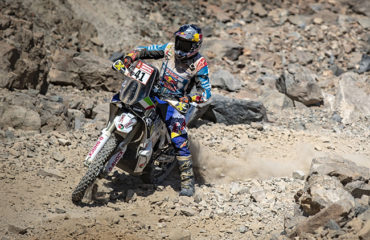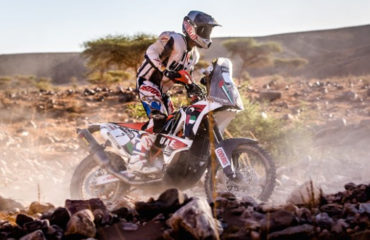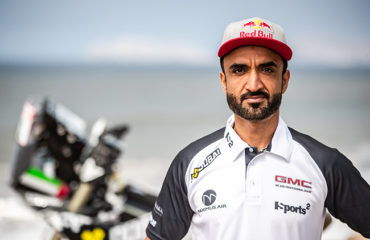
Over the 41 years of history that have passed since its first edition back in 1978, Dakar Rally has gained a solid reputation of being the toughest race on Earth, a race infamous for pushing people and machines to their limits during 2 weeks, and once they all reach their limits, pushing them a lot further making every day a battle for survival. A very uneven fray between competitors and the odds, with extreme climate, ever changing terrain, hidden dangers of all kinds, and all the technical and navigational difficulties Dakar keeps throwing at them at every step of the way. The daily battle is not only for better results, in fact competitors have to battle just to be able to overcome all possible obstacles and stay in the competition, making those capable of enduring through all the endless hardship Dakar has up the sleeve, super-humans, true elite athletes.
UAE motocross multiple champion and FIM Bajas World Cup Winner Mohammed al Balooshi knows a thing or two about overcoming obstacles, having made his come-backs after injury several times over his 18 year’s career in the motorsport, and his strength and determination are well know in the circuit… his will power gained extra notoriety a couple of years ago when, after leading the entire race, he pushed his faulty motorcycle for 5 kilometers through the Egyptian desert at the final stage of the Pharaohs Rally, to end up with a fabulous podium position. But Dakar is Dakar, and because of that, it can be more merciless than any other race on the planet.

The second day of the competition, which departed from Pisco and finished at the rally bivouac set outside of San Juan de Marcona -down to the south of Peru’s capital, Lima- covered 553 kilometers of a terrain that, very tricky and with plenty of hidden dangers, but that does suit Mohammed’s Al Balooshi’s riding style. The Emirati started the day in great shape climbing 12 positions in the first 200 kilometers of special stage. He made no navigational mistakes and managed to negotiate the very poor terrain conditions, very bumpy and rocky on the hard-pack areas after the cars had been through. Oceans of sand and fesh-fesh, this super thin sand which is soft as talcum powder and where, if you happen to walk in it, you will sink immediately up to level of your knee, that soft and fluffy is it. A fast pace catching up on the cars and buggies that started earlier added to the very dusty conditions difficulting visibility…. Until here all was running within what would be almost “another day at the office” in a day at Dakar.
Then disaster came for Mohammed Al Balooshi when his motorcycle came to a complete standstill, absolutely out of petrol. The issue that delayed him during the first day of the race with the fuel supply and carburant circulation between tanks, after apparently having been solved, tricked the mechanics giving them wrong lectures about the petrol levels. As a result, he run out of petrol 200 kilometers into the time-controlled section, deep inside the dunes, and 30 kilometers away from the refueling point. The sad part is that because of a wrong reading, in reality the bike left the service park in the early morning without enough fuel for the day. Without knowing it, Balooshi was heading for disaster and had never even stand a chance of making it to the refueling point.
Balooshi struggled in the dunes for a while trying to find out what was the problem first, pushing for a while later on, asking other competitors to stop and help without any luck. The only UAE National participating in Dakar Rally 2019 was very close to calling it quits, being forced to retire, when two competitors finally stopped and assisted him. “There was absolutely nothing else I could do at this point and ended up at the mercy of other competitors who were also tight on petrol. I need to thank Benji Melot who stopped first and gave me a connector, which allowed me to pull petrol from another bike. And then I can’t thank Abdullah Al Shatti enough for his help. Knowing he had just enough to reach the refueling himself, he generously gave me some of his petrol and once we got moving again, we rode together until the refueling point sharing the little fuel he had, and we both arrived to the pump with the last drop in our tanks. Abdullah saved my race, because otherwise I would have been forced to retire.” Explained Al Balooshi late in the evening from the bivouac. And he added “It was a simple mechanical mistake based on a problem that apparently had been solved on the first day, but tricked the mechanics with false readings. We lost more than one hour, which heavily impacted in the race standings, but tomorrow will be a new day and I’ll do my best to recover some of that time. I need to apologize for not doing well today, there is a lot of people back home following my progress and today we all ended up disappointed. We still have 8 more days to go, and I will continue to work hard as ever to make up for the time lost.”
The third day of the competition will cover a total of 798 kilometers and will be the toughest one yet, with a very early start- before dawn- from the bivouac in San Juan de Marcona. This day will unveil an area of dunes which will be completely new even to the Dakar habitués, in the region of Ancari; so once again, a day of extreme challenges navigating the endless dunes softened under the sun and high temperatures of the Peruvian summer is expected. After yesterday’s petrol supply disappointment, Mohammed Al Balooshi went from position 35 in the stage when all was good, down to 72 when disaster hit. He was able to recover some positions after replenishing his Husqvarna’s petrol tanks at the refueling point, but upon arrival to the end of the stage he had literally lost 23 positions, ending up in 58th.
A rather heartbreaking aftermath, which will force the Emirati star rider to stay focused and push hard to regain some of the time and positions lost. Stage 3 will cross some amazing scenery to finish in the outskirts of the beautiful and culturally rich city of Arequipa, some 2,300 mts above sea level. Arequipa is the second most populous city in Peru, after the capital, and it constitutes one of the cities with highest historical value of South America.
Additional Info:
Natalia@sports2.net
Mb. 055 – 929 8025



